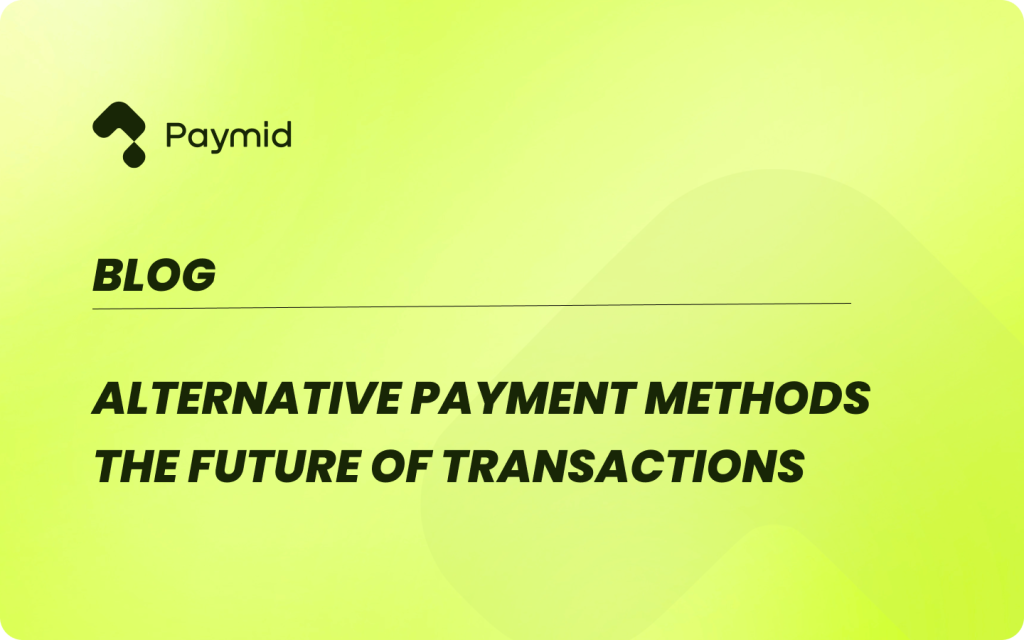Alternative Payment Methods: The Future of Transactions

In today’s digital society, alternative payment methods such as e-wallets and various online payment options are rapidly becoming the norm, offering convenience and security beyond traditional transaction methods. Recognizing the shift, platforms like Centralisera have expanded their services to support a wide array of these innovative payment solutions, catering to a global audience.
This article delves into the benefits of adopting alternative payment methods, explores the most common types, and examines global trends shaping the future of transactions. It also provides insights on integrating these modern payment options into your business, guiding you towards a more inclusive and forward-thinking approach.
Read More:
- How To Integrate Embedded Payments Into Your Platform?
- Partial Payment Meaning: Framework, Compliance & Strategy
- PCI Compliance Checklist – Safeguarding Sensitive Information
- Guide to Payment Tokenization & Card Security
Benefits of Adopting Alternative Payment Methods
Expanding Market Reach and Enhancing Customer Experience
Alternative payment methods (APMs) such as e-wallets, mobile money, and carrier billing extend the reach of businesses globally by breaking down geographical barriers inherent in traditional banking systems. This accessibility allows businesses to tap into new markets with ease. Additionally, the convenience of APMs, enabling transactions with just a few taps on a mobile device, significantly enhances the customer experience. This ease of use leads to higher customer satisfaction rates and can result in increased brand loyalty and repeat business.
Cost Efficiency and Security Advantages
Employing alternative payment methods can lead to substantial cost savings for businesses, particularly small enterprises. These methods often incur lower transaction fees than traditional credit card payments, which have seen a significant increase over the past decade. Moreover, APMs leverage advanced technologies to offer enhanced security measures and fraud protection, giving both businesses and consumers peace of mind. The integration of robust security protocols in APMs minimizes the risk of fraud, making them a safer choice for online transactions.
Driving Sales and Innovative Payment Solutions
The flexibility and innovative features of alternative payment methods, such as Buy Now, Pay Later (BNPL) options and simple bank-to-bank transfers, cater to the evolving needs of modern consumers. These features not only provide convenience but also introduce a level of purchasing flexibility that can boost sales.
The adoption of APMs is driven by consumer demand for frictionless, rewarding experiences and by merchants’ desires to reduce payment acceptance costs and grow sales. Offering cutting-edge payment solutions can also create new revenue streams and enhance customer engagement by integrating rewards and personalization into the payment process.
Common Types of Alternative Payment Methods
Digital Wallets and Mobile Payments
- Digital Wallets: Digital wallets, such as PayPal, Apple Pay, and Google Pay, dominate e-commerce transactions by offering users the ability to store multiple forms of payment in one secure location. These wallets simplify the checkout process on various platforms and increase security by minimizing the need to share credit card information directly with merchants.
- Mobile Payments: Utilizing technologies like NFC (Near Field Communication) and QR codes, mobile payments allow consumers to make purchases by simply tapping or scanning their devices. Popular platforms include Samsung Pay and Apple Pay, which not only enhance convenience but also provide additional security layers through tokenization.
Cryptocurrencies and Biometric Payments
- Cryptocurrencies: Serving as both an investment and a payment method, cryptocurrencies like Bitcoin and Ethereum offer users anonymity and reduced transaction fees. These digital currencies are becoming increasingly accepted by merchants worldwide, appealing especially to a tech-savvy audience.
- Biometric Payments: This method uses unique personal features such as fingerprints or facial recognition to authenticate transactions, adding a layer of security that is difficult to breach. Biometric systems are integrated into mobile devices and are rapidly gaining popularity due to their ease of use and enhanced security features.
Bank Transfers and Buy Now, Pay Later (BNPL)
- Direct Bank Transfers: Often facilitated by services like ACH in the U.S., direct bank transfers are a reliable method for transferring funds directly between bank accounts without using a credit or debit card. This method is particularly useful for larger transactions and recurring payments.
- Buy Now, Pay Later: BNPL services have surged in popularity, offering consumers the ability to defer payments or split purchases into installments. This flexibility can boost merchant sales by making higher-priced items more accessible to customers who prefer not to pay the full amount upfront.
Global Trends in Payment Methods
Expanding Global Adoption and Technological Integration
As the landscape of global transactions evolves, alternative payment methods (APMs) are seeing widespread adoption. Notably, DPMax offers a unique solution by combining local payment methods with international capabilities, facilitating instant, chargeback-free transactions across Europe. This trend is mirrored globally, with a significant 85% of large U.S. merchants planning to integrate new APMs within the next three years. The drive towards cashless societies is further underscored by projections that global cashless payment volumes will surge to 1.9 trillion transactions by 2025, marking an 80% increase from 2020.
The Rise of Embedded Finance and Augmented Reality
Embedded finance continues to gain traction, particularly among millennials, 37% of whom express strong interest in accessing financial services through non-financial retailers. This shift is poised to redefine consumer interactions with financial products, integrating them seamlessly into everyday shopping experiences. Simultaneously, Augmented Reality (AR) is set to transform the shopping experience for Gen Z consumers, who show a readiness to engage in and spend through immersive experiences. These technologies not only enhance user engagement but also open new avenues for personalized marketing and sales strategies.
Central Bank Digital Currencies and Real-Time Payments
The momentum for Central Bank Digital Currencies (CBDCs) is growing, with over 90% of central banks exploring CBDC initiatives. Countries like China, Sweden, and the United States are at the forefront of this exploration, aiming to modernize their financial infrastructures. Additionally, Real-Time Payments (RTP) are expected to represent 28% of all electronic payments globally by 2027, reflecting a shift towards more immediate and accessible financial transactions. This trend is complemented by a growing demand for diverse payment options across Asia, the Middle East, and Africa, where local methods like WeChat Pay and Alipay are gaining popularity.
Implementing Alternative Payment Methods in Your Business
Implementing alternative payment methods (APMs) like e-wallets and other digital solutions in your business involves several strategic steps to ensure a smooth integration and adoption. Centralisera, as a comprehensive platform, offers Global Payments, Revenue and Finance Automation, and Banking-as-a-Service solutions that simplify the setup of new payment methods. This allows businesses to stay current with payment trends while focusing on other critical tasks.
- Initial Assessment and Planning:
- Assess Customer Base: Understanding the payment preferences of your customer base is crucial. Conduct surveys and market research to identify preferred payment methods in different regions.
- Explore Payment Options: Evaluate a range of APMs, considering their pros and cons. Choose methods that align with both business objectives and customer needs.
- Regulatory and Security Measures: Navigate the regulatory landscape for each payment method and implement robust security measures to protect customer data and ensure compliance.
- Integration and Optimization:
- Technology Preparation: Prepare your website or app for the integration of new payment options. Select a payment gateway that supports the chosen methods and ensures seamless integration for a frictionless checkout experience.
- Optimize Payment Process: Enhance the payment process for speed and ease of use to improve customer satisfaction. Monitor and manage the adoption of APMs with real-time transaction insights.
- Staff Training and Customer Support: Train staff to assist customers with new payment methods and provide responsive support for payment-related inquiries.
- Testing, Feedback, and Promotion:
- Conduct Thorough Testing: Identify and resolve any issues to ensure a smooth rollout. Optimize the payments technology stack for seamless integration.
- Gather Customer Feedback: Continuously improve by gathering feedback and making necessary adjustments.
- Promote New Payment Options: Increase adoption by promoting the availability of new payment options to your audience, focusing on the benefits and ease of use.
By following these steps, businesses can effectively implement and maximize the benefits of alternative payment methods, enhancing customer satisfaction and potentially increasing sales.
Our Final Thoughts
As we have explored, the integration of alternative payment methods within the digital economy is not just an emerging trend but a pivotal transition towards more inclusive, efficient, and secure transactions. The embrace of e-wallets, mobile payments, cryptocurrencies, and other innovative solutions presents a multitude of benefits, from expanding market reach and enhancing customer satisfaction to driving sales and bolstering security. These advancements herald a significant shift in consumer behavior and open up unprecedented opportunities for businesses willing to adapt to the evolving landscape of global transactions.
Looking ahead, the continued adoption and development of alternative payment methods are set to redefine the benchmarks for convenience, security, and innovation in the financial sector. Businesses that proactively integrate these payment solutions stand to gain a competitive edge, tapping into new markets and meeting the rising expectations of a digitally savvy consumer base. As the digital economy grows, staying abreast of these changes and leveraging the potential of alternative payment methods will be crucial for any venture looking to thrive in the modern marketplace.
FAQs
What will be the predominant method of alternative payments by 2024?
Digital wallets are projected to become the most popular method of online payment globally by 2024, surpassing both credit cards and cash. Additionally, peer-to-peer payments are gaining traction as a significant alternative payment method.
How will transactions be conducted in the future?
By 2025, it is expected that cash will be used in less than 30% of all transactions worldwide. Card payments will continue to dominate as the preferred payment method, with mobile payments following closely behind.
What are the projections for the growth of digital payments?
The digital payments sector, particularly in India, is anticipated to expand significantly, with a compound annual growth rate (CAGR) of 50% expected. By the fiscal year 2026-27, the number of transactions could surpass 400 billion, a substantial increase from 100 billion in fiscal year 2022-23. This growth is largely driven by the adoption of the Unified Payment Interface (UPI) and other digital payment methods that enhance convenience and reduce costs for small businesses.
Why should we consider using alternative payment methods?
Alternative payment methods, such as digital payments, offer considerable cost savings and increased efficiency. These methods often incur lower transaction costs compared to traditional banking services, which can include various fees and charges. This is particularly beneficial for individuals and businesses, especially those in low-income areas, helping to make financial transactions more accessible and affordable.

